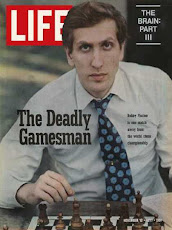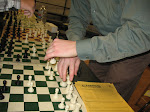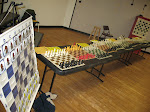KEEPING YOUR KING SAFE:
 CASTLING!
CASTLING!
*
Castle early and castle often - 99% of the time!
BELOW IS THE START POSITION
-
This is what our chess board should look like at the start of a game of chess.
Remember "Light on Right" - there should be a white square in the right hand corner of the board.
 CASTLING!
CASTLING!*
Castle early and castle often - 99% of the time!
BELOW IS THE START POSITION
-
This is what our chess board should look like at the start of a game of chess.
Remember "Light on Right" - there should be a white square in the right hand corner of the board.

IN THIS LESSON YOU WILL LEARN:
- How to correctly castle your King
- What three things we want to achieve in the opening.
- How to play three easy moves as White - as long as your opponent goes along with this - to help keep your King safe, control the center and to develop your team. In other words how to play an opening - a very famous one called the RUY LOPEZ.
- Our fair share of the center - or all of it!
- To develop our team.
- To keep our King safe.
If we can achieve all three of these objectives then we shall have a very good game ahead of us and we will have made it out of the opening without having been checkmated.
I will show you how to achieve all three of these objectives in our next example - where our King castles King-side. I will use an example from a well known opening - one in which the first player/white player castles to the King's side of the board. The opening I am going to show you is the RUY LOPEZ - which only takes three easy moves from White and Black.
Whenever we open a game of chess we must respond to what our opponent's threats are - so if we cannot play our favorite opening by "wrote" - because our opponent has chosen a different opening set up then, as always, we just want to get our pieces out onto good squares and try to both create and watch out for tactical threats.
Remember to refer back to the PDF file that I have sent out to all members of the Eagles Chess Community - this will help you to read and understand the move list I will provide down below:
After the moves:
I will show you how to achieve all three of these objectives in our next example - where our King castles King-side. I will use an example from a well known opening - one in which the first player/white player castles to the King's side of the board. The opening I am going to show you is the RUY LOPEZ - which only takes three easy moves from White and Black.
Whenever we open a game of chess we must respond to what our opponent's threats are - so if we cannot play our favorite opening by "wrote" - because our opponent has chosen a different opening set up then, as always, we just want to get our pieces out onto good squares and try to both create and watch out for tactical threats.
Remember to refer back to the PDF file that I have sent out to all members of the Eagles Chess Community - this will help you to read and understand the move list I will provide down below:
After the moves:
- e4 e5
- Nf3 Nc6
- Bb5
We have our opening that we want to play as White - the RUY LOPEZ. Three golden moves have gotten us there!
- White plays a pawn to the e4 square, one of four key central squares that we want to control or own.
- White plays out his King side Knight first - Usually we play Knights before Bishops because they take longer to get to where they need to go sometimes. A simple rule of thumb - not always true but good advice to follow just the same.
- White plays out his King side Bishop - developing this piece to a great square where it attacks the Knight on c6.
- He/she controls some of the center
- She/he is developing their pieces - the Knight and the Bishop are out on the field.
- AND... the first player/player of the white pieces is ready to castle! KING SAFETY - very important no matter how we open up our game!
- e4 e5
- Nf3 Nc6
- Bb5 a6
- Ba4 Nf6
We reach the well known position given below:

It is White's turn here.... what do we need to do now? Aha - keep our King safe!
BUT HOW DO WE DO THAT?

Maybe keeping our King safe is a good idea? What is the best way to do this in a game of chess - at least during the opening. Castling! We can castle to either side of the board - when there aren't any of our other pieces in the way and if we can safely answer no to all of the following questions we should ask before attempting to castle:
- First off - is our King in Check? No.
- Are either of the squares with circles on them being looked at by enemy pieces or pawns? No.
- Have we moved our King yet? No.
- Have we moved the Rook on h1? No.
- Pick up your King.
- Count two squares over towards the side of the board that you want to castle towards.
- Put the King on the second of these two squares. In the above position we want to put our King on the "g1-square" - the square that has a circle on it and that is next to the Rook on h1.
- Pick up the Rook and place him down next to the King - but on the other side of the King.

White's King is safe now! Or at least a lot safer than he would be if he were stuck in the center of the board - where Black's King is right now!
Ok - so that was castling to the King's side of the board - but how about going to the other side of the board. That is can we castle to the Queen's side of the board?
YES - WE CAN! (Sorry President Obama!!)
In the position given below we have reached a very popular moment in an opening known as "The Sicilian Dragon". White can play a couple of good moves here but one that is very popular features the first player getting his King to the relative safety of the Queen's side of the board.

After the moves:
- e4 c5
- Nf3 d6
- d4 cxd4
- Nxd4 Nf6
- Nc3 g6
- Be3 Bg7
- f3 Nc6
- Qd2 0 - 0
 Ok - let us all go through our "check" list to see if we can castle to this side of the board.
Ok - let us all go through our "check" list to see if we can castle to this side of the board.- Is our King in check? No - so we will be able to castle. Remember you can NEVER CASTLE OUT OF CHECK as you must first either CAPTURE the piece giving check, BLOCK the check or RUN AWAY. The King can move one square in any direction to get out of check but he can never use the Special move to get away from a check. The check will take away this Special move.
- Have we moved our King during a previous turn? No - so we will be able to castle.
- Have we moved our Rook on a1 during a previous turn? No - so we will be able to castle.
- Are either of the squares with circles on them attacked by enemy pieces? No - so we can castle in that case then.
- Are all of the white pieces (Queen, Bishop and Knight) out of the way of the King and the Rook on a1? Yes - they are so we can pass through those empty squares while castling.
- Pick up your King.
- Count two squares over towards the side of the board that you want to castle towards.
- Put the King on the second of these two squares. In the above position we want to put our King on the "c1-square" - the square that has a circle on it and is the furthest of the two circled squares away from the White King.
- Pick up the Rook and place him down next to the King - but on the other side of the King.
Would you like to take a guess as to how we would write this move down? If you said or wrote down the move...

9. 0 - 0 - 0 giving an "o" for every square between the King and the Rook then you are correct! Well done!!
In both of these examples on how to castle we have seen both players look after their King's safety by using the special move CASTLES. In any opening we want to always achieve three objectives - get three things accomplished:
- CONTROL THE CENTER.
- DEVELOP YOUR TEAM/ARMY.
- KEEP YOUR KING SAFE.
WE MUST NEVER JUST DEVELOP OUR PIECES WITHOUT WATCHING OUT FOR OUR OPPONENT'S THREATS... this too is part of "KING SAFETY". HERE IS AN EXAMPLE DOWN BELOW:

After the moves:
- e4 e5
- Nf3 Nc6
- Bc4 Nf6
- Ng5!
We need to develop our team - but we always need to watch out for the threats that our opponent will try to make against our pieces and in particular against our King.
I hope you have enjoyed part one of our lesson on Special Moves... part two is given immediately after this (Chronologically before this... I wasn't playing by normal blogger rules in making these postings!)
Your Cherokee Chargers Chess Coach
Coach Sean Tobin







No comments:
Post a Comment